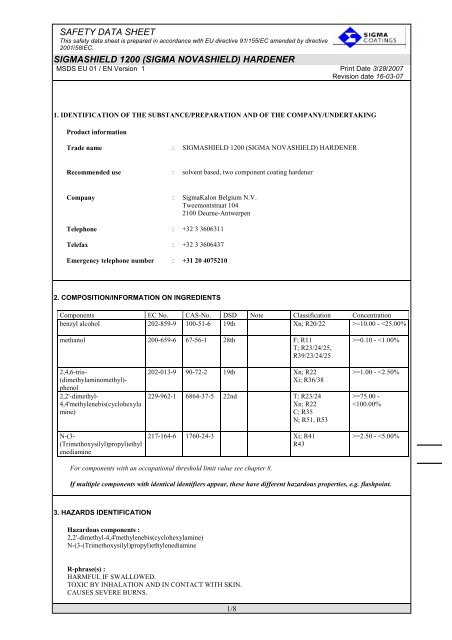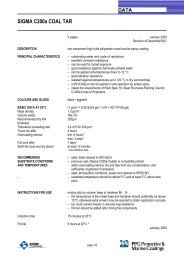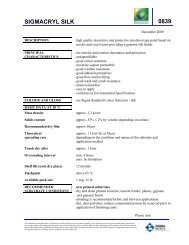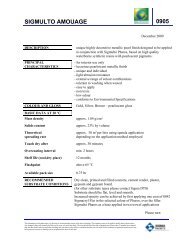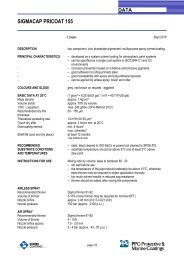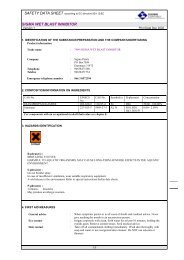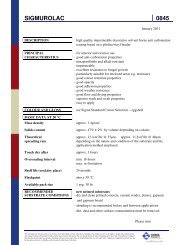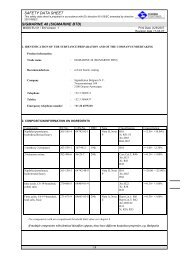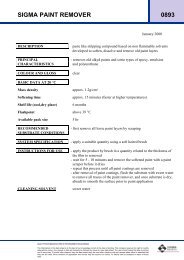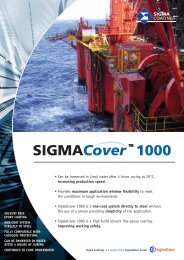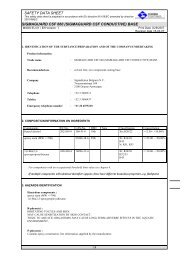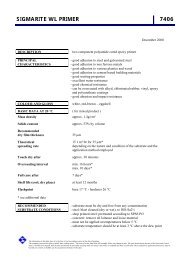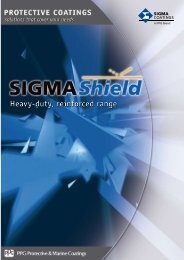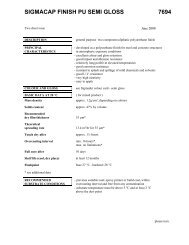msds sigmashield 1200 hardener - SIGMA PAINTS
msds sigmashield 1200 hardener - SIGMA PAINTS
msds sigmashield 1200 hardener - SIGMA PAINTS
Create successful ePaper yourself
Turn your PDF publications into a flip-book with our unique Google optimized e-Paper software.
SAFETY DATA SHEET<br />
This safety data sheet is prepared in accordance with EU directive 91/155/EC amended by directive<br />
2001/58/EC.<br />
<strong>SIGMA</strong>SHIELD <strong>1200</strong> (<strong>SIGMA</strong> NOVASHIELD) HARDENER<br />
MSDS EU 01 / EN Version 1 Print Date 3/28/2007<br />
Revision date 16-03-07<br />
1. IDENTIFICATION OF THE SUBSTANCE/PREPARATION AND OF THE COMPANY/UNDERTAKING<br />
Product information<br />
Trade name : <strong>SIGMA</strong>SHIELD <strong>1200</strong> (<strong>SIGMA</strong> NOVASHIELD) HARDENER<br />
Recommended use : solvent based, two component coating <strong>hardener</strong><br />
Company : SigmaKalon Belgium N.V.<br />
Tweemontstraat 104<br />
2100 Deurne-Antwerpen<br />
Telephone : +32 3 3606311<br />
Telefax : +32 3 3606437<br />
Emergency telephone number : +31 20 4075210<br />
2. COMPOSITION/INFORMATION ON INGREDIENTS<br />
Components EC No. CAS-No. DSD Note Classification Concentration<br />
benzyl alcohol 202-859-9 100-51-6 19th Xn; R20/22 >=10.00 - =0.10 - =1.00 - =75.00 -<br />
=2.50 -
SAFETY DATA SHEET<br />
This safety data sheet is prepared in accordance with EU directive 91/155/EC amended by directive<br />
2001/58/EC.<br />
<strong>SIGMA</strong>SHIELD <strong>1200</strong> (<strong>SIGMA</strong> NOVASHIELD) HARDENER<br />
MSDS EU 01 / EN Version 1 Print Date 3/28/2007<br />
Revision date 16-03-07<br />
MAY CAUSE SENSITIZATION BY SKIN CONTACT.<br />
TOXIC TO AQUATIC ORGANISMS, MAY CAUSE LONG-TERM ADVERSE EFFECTS IN THE AQUATIC<br />
ENVIRONMENT.<br />
4. FIRST AID MEASURES<br />
General advice : When symptoms persist or in all cases of doubt seek medical advice. Never<br />
give anything by mouth to an unconscious person.<br />
Eye contact : Irrigate copiously with clean, fresh water for at least 10 minutes, holding the<br />
eyelids apart. Remove contact lenses. Seek medical advice.<br />
Skin contact : Take off all contaminated clothing immediately. Wash skin thoroughly with<br />
soap and water or use recognized skin cleanser. Do NOT use solvents or<br />
thinners.<br />
Inhalation : Remove to fresh air. Keep patient warm and at rest. If breathing is irregular<br />
or stopped, administer artificial respiration. If unconscious place in recovery<br />
position and seek medical advice.<br />
Ingestion : If accidently swallowed obtain immediate medical attention. Keep at rest. Do<br />
not induce vomiting.<br />
Burns : If spills on clothing catch fire, wash with plenty of water. Remove loose<br />
clothing. Do not remove clothing that has melted to the skin.Obtain medical<br />
attention.<br />
5. FIRE-FIGHTING MEASURES<br />
Specific hazards during fire<br />
fighting<br />
: As the product contains combustible organic components, fire will produce<br />
dense black smoke containing hazardous products of combustion (see section<br />
10). Exposure to decomposition products may be a hazard to health. Cool<br />
closed containers exposed to fire with water spray. Do not allow run-off from<br />
fire fighting to enter drains or water courses.<br />
: In the event of fire, wear self-contained breathing apparatus.<br />
Special protective equipment<br />
for fire-fighters<br />
Suitable extinguishing media : Use water spray, alcohol-resistant foam, dry chemical or carbon dioxide.<br />
Keep containers and surroundings cool with water spray.<br />
Extinguishing media which : Do NOT use water jet.<br />
must not be used for safety<br />
reasons<br />
6. ACCIDENTAL RELEASE MEASURES<br />
Personal precautions : Use personal protective equipment. Ventilate the area. Refer to protective<br />
measures listed in sections 7 and 8. Wear respiratory protection. Beware of<br />
vapours accumulating to form explosive concentrations. Vapours can<br />
accumulate in low areas. Remove all sources of ignition.<br />
Environmental precautions : Try to prevent the material from entering drains or water ways. If the product<br />
contaminates rivers and lakes or drains inform respective authorities.<br />
Methods for cleaning up : Clean with detergents. Avoid solvents. Contain and collect spillage with noncombustible<br />
absorbent material, (e.g. sand, earth, diatomaceous earth,<br />
vermiculite) and place in container for disposal according to local / national<br />
regulations (see section 13).<br />
Additional advice : Refer to section 15 for specific national regulation.<br />
2/8
SAFETY DATA SHEET<br />
This safety data sheet is prepared in accordance with EU directive 91/155/EC amended by directive<br />
2001/58/EC.<br />
<strong>SIGMA</strong>SHIELD <strong>1200</strong> (<strong>SIGMA</strong> NOVASHIELD) HARDENER<br />
MSDS EU 01 / EN Version 1 Print Date 3/28/2007<br />
Revision date 16-03-07<br />
7. HANDLING AND STORAGE<br />
Handling<br />
Safe handling advice : Avoid exceeding of the given occupational exposure limits (see section 8).<br />
Use only in area provided with appropriate exhaust ventilation. Avoid contact<br />
with skin, eyes and clothing. Smoking, eating and drinking should be<br />
prohibited in the application area. Avoid inhalation of vapour or mist. For<br />
personal protection see section 8.<br />
Advice on protection against<br />
fire and explosion<br />
: Prevent the creation of flammable or explosive concentrations of vapour in<br />
air and avoid vapour concentration higher than the occupational exposure<br />
limits. When transferring from one container to another apply earthing<br />
measures and use conductive hose material. No sparking tools should be<br />
used. Take necessary action to avoid static electricity discharge (which might<br />
cause ignition of organic vapours). The product should only be used in areas<br />
from which all naked lights and other sources of ignition have been excluded.<br />
No smoking. The accumulation of contaminated rags and dry overspray,<br />
particularly in spray booth filters, may result in spontaneous combustion.<br />
Good housekeeping standards, regular safe removal of waste materials and<br />
regular maintenance of spray booth filters will minimise the risks of<br />
spontaneous combustion and other fire hazards.<br />
Storage<br />
Requirements for storage areas<br />
and containers<br />
: Observe label precautions. Prevent unauthorized access. Containers which<br />
are opened must be carefully resealed and kept upright to prevent leakage.<br />
Store between 5 and 25°C (41 - 77 F) in a dry, well ventilated place away<br />
from sources of heat, ignition and direct sunlight. Solvent vapours are heavier<br />
than air and may spread along floors. Vapours may form explosive mixtures<br />
with air. Electrical installations / working materials must comply with the<br />
technological safety standards. Keep away from sources of ignition - No<br />
smoking. Store in accordance with the particular national regulations (see<br />
section 15).<br />
Advice on common storage : Keep away from oxidising agents and strongly acid or alkaline materials.<br />
8. EXPOSURE CONTROLS / PERSONAL PROTECTION<br />
Minimum ventilated air quantity for 1 liter of product<br />
TO REACH 10 % LEL : 22 m3/l<br />
Components on the national list and/or the European TLV list (98/24/EC):<br />
Components CAS-No. Value Value Basis<br />
[mg/m 3 ] [ppm]<br />
methanol<br />
can be absorbed through skin<br />
67-56-1 260 200 EU ELV TWA<br />
Personal protective equipment<br />
General advice<br />
Respiratory protection : When operators, whether spraying or not, have to work inside the spray<br />
booth, ventilation is unlikly to be sufficient to control particulates and solvent<br />
vapour in all cases. In such circumstances they should wear a compressed airfed<br />
respirator during the spraying process and until such time as the<br />
particulates and solvent vapour concentration has fallen below the exposure<br />
limits.<br />
3/8
SAFETY DATA SHEET<br />
This safety data sheet is prepared in accordance with EU directive 91/155/EC amended by directive<br />
2001/58/EC.<br />
<strong>SIGMA</strong>SHIELD <strong>1200</strong> (<strong>SIGMA</strong> NOVASHIELD) HARDENER<br />
MSDS EU 01 / EN Version 1 Print Date 3/28/2007<br />
Revision date 16-03-07<br />
Hand protection : For prolonged or repeated contact use protective gloves.<br />
Barrier creams may help to protect the exposed areas of skin, they should<br />
however not be applied once exposure has occurred.<br />
Skin should be washed after contact.<br />
Use chemical resistant gloves classified under Standard EN 374: Protective<br />
gloves against chemicals and micro-organisms.<br />
Recommended gloves: butyl-rubber<br />
Minimum breakthrough time: 480 min<br />
The recommended gloves are based on most common solvent in this product.<br />
When prolonged or frequently repeated contact may occur, a glove with a<br />
protection class of 6 (breakthrough time greater than 480 minutes according<br />
to EN 374) is recommended. When only brief contact is expected, a glove<br />
with a protection class of 2 or higher (breakthrough time greater than 30<br />
minutes according to EN 374) is recommended.<br />
NOTICE: The selection of a specific glove for a particular application and<br />
duration of use in a workplace should also take into account all relevant<br />
workplace factors such as, but not limited to: Other chemicals which may be<br />
handled,physicalrequirements (cut/puncture protection, dexterity, thermal<br />
protection), potential body reactions to glovematerials, as wellas the<br />
instructions/specifications provided by the glove supplier.<br />
Eye protection : Chemical resistant goggles must be worn.<br />
Skin and body protection : Personnel should wear protective clothing. Skin should be washed after<br />
contact. Working clothes must not consist of textiles, which show a<br />
dangerous melting behaviour in case of fire. Workers should wear antistatic<br />
footwear.<br />
Additional advice<br />
Environmental protection : Refer to national regulations in chapter 15 for regulations on environmental<br />
protection.<br />
Personal protection<br />
Protective equipment : P3A3 full-face combi mask, safety gloves, safety suit and boots<br />
Please contact your personal protection equipment supplier for further advice<br />
9. PHYSICAL AND CHEMICAL PROPERTIES<br />
Form : liquid<br />
Colour : various<br />
Odour : strong amine-like<br />
Flash point : 106.0 °C<br />
Note: Calculated<br />
Autoignition temperature : > 426 °C<br />
Upper explosion limit : 16.35 %(V)<br />
Lower explosion limit : 1.65 %(V)<br />
Density : 0.96 g/cm3<br />
at 20 °C<br />
Water solubility : completely soluble<br />
pH :<br />
Viscosity, dynamic : 180 mPa.s at 23 °C<br />
Flow time : 15 s<br />
Transversal section: 6 mm<br />
Method: ISO 2431 (EN 535) 6 mm CUP<br />
4/8
SAFETY DATA SHEET<br />
This safety data sheet is prepared in accordance with EU directive 91/155/EC amended by directive<br />
2001/58/EC.<br />
<strong>SIGMA</strong>SHIELD <strong>1200</strong> (<strong>SIGMA</strong> NOVASHIELD) HARDENER<br />
MSDS EU 01 / EN Version 1 Print Date 3/28/2007<br />
Revision date 16-03-07<br />
10. STABILITY AND REACTIVITY<br />
Conditions to avoid : Avoid temperatures above 60°C (140 F), direct sunlight and contact with<br />
sources of heat.<br />
Hazardous reactions : Keep away from oxidising agents, strongly alkaline and strongly acid<br />
materials in order to avoid exothermic reactions.<br />
Hazardous decomposition<br />
products<br />
: In case of fire hazardous decomposition products may be produced such as:<br />
Carbon dioxide (CO2), carbon monoxide (CO), oxides of nitrogen (NOx),<br />
dense black smoke.<br />
11. TOXICOLOGICAL INFORMATION<br />
Acute oral toxicity : May cause nausea, abdominal spasms and irritation of the mucous<br />
membranes.<br />
Acute inhalation toxicity : Exposure to component solvent vapours concentration in excess of the stated<br />
occupational exposure limit may result in adverse health effects. Such as:<br />
mucous membrane irritation, respiratory system irritation, adverse effects on<br />
kidney, liver and central nervous system. Symptoms and signs: headache,<br />
dizziness, fatigue, muscular weakness, drowsiness and in extreme cases loss<br />
of consciousness.<br />
Skin irritation : Repeated or prolonged contact with the preparation may cause removal of<br />
natural fat from the skin resulting in desiccation of the skin. The product may<br />
be absorbed through the skin.<br />
Eye contact : May cause irreversible eye damage.<br />
Further information : There is no data available for this product.<br />
Acute Toxicity Data for Components<br />
benzyl alcohol(100-51-6)<br />
Acute oral toxicity : LD50: 1,230 mg/kg (rat)<br />
Acute dermal toxicity : LD50: 2,000 mg/kg (rabbit )<br />
2,4,6-tris-(dimethylaminomethyl)-phenol(90-72-2)<br />
Acute oral toxicity : LD50: 200 - 2,000 mg/kg (rat)<br />
Acute dermal toxicity : LD50: 1,350 mg/kg (rabbit )<br />
2,2'-dimethyl-4,4'methylenebis(cyclohexylamine)(6864-37-5)<br />
Acute oral toxicity : LD50: 320 - 460 mg/kg (rat)<br />
Acute inhalation toxicity : LC50: 0.42 mg/l (rat, 4 h)<br />
Acute dermal toxicity : LD50: 200 - 400 mg/kg (rat, )<br />
12. ECOLOGICAL INFORMATION<br />
Further information : The preparation has been assessed following the conventional method of the<br />
Dangerous Preparations Directive 1999/45/EC and is classified for<br />
ecotoxicological properties accordingly. See sections 2 and 15 for details.<br />
5/8
SAFETY DATA SHEET<br />
This safety data sheet is prepared in accordance with EU directive 91/155/EC amended by directive<br />
2001/58/EC.<br />
<strong>SIGMA</strong>SHIELD <strong>1200</strong> (<strong>SIGMA</strong> NOVASHIELD) HARDENER<br />
MSDS EU 01 / EN Version 1 Print Date 3/28/2007<br />
Revision date 16-03-07<br />
13. DISPOSAL CONSIDERATIONS<br />
Product : The product should not be allowed to enter drains, water courses or the soil.<br />
Disposal together with normal waste is not allowed. Special disposal required<br />
according to local regulations.<br />
Waste key for the unused<br />
product<br />
: The European Waste Catalogue classification of this product, when disposed<br />
of as waste is:<br />
08 01 11 Waste paint and varnish containing organic solvents or other<br />
dangerous substances.<br />
If this product is fully cured or mixed with other wastes, this code may no<br />
longer apply. If mixed with other wastes, the appropriate code should be<br />
assigned. For further information contact your local waste authority<br />
14. TRANSPORT INFORMATION<br />
Transport within user's premises: always transport in closed containers that are upright, labelled and secure. Ensure that<br />
persons transporting the product know what to do in the event of an accident or spillage.<br />
Transport to be in accordance with ADR for road, IMDG for sea and IATA for air transport:<br />
UN-No : 2922<br />
Proper shipping name : CORROSIVE LIQUID, TOXIC, N.O.S.<br />
Class : 8<br />
Sub Class : 6.1<br />
Packing group : II<br />
Label : 8 + 6.1<br />
Proper shipping name (ADR) : CORROSIVE LIQUID, TOXIC, N.O.S.<br />
Technical name 1 : dimethyl diamino dicyclohexyl methane<br />
Marine Pollutant (IMDG)(P,PP,-) : P<br />
Marine Pollutant component (IMDG) : dimethyl diamino dicyclohexyl methane<br />
EmS (IMDG) : F-A, S-B<br />
Limited quantity (ADR) : Max. per inner pack. : 1.00 L<br />
Max. per outer pack. : 4.00 KG<br />
Limited quantity (IMDG) : Max. per inner pack. : 1.00 L<br />
Max. per outer pack. : 30.00 KG<br />
15. REGULATORY INFORMATION<br />
The product is classified and labelled in accordance with Directive 1999/45/EC.<br />
Toxic<br />
Dangerous for the<br />
environment<br />
Hazardous components which must be listed on the label:<br />
• 2,2'-dimethyl-4,4'methylenebis(cyclohexylamine)<br />
• N-(3-(Trimethoxysilyl)propyl)ethylenediamine<br />
6/8
SAFETY DATA SHEET<br />
This safety data sheet is prepared in accordance with EU directive 91/155/EC amended by directive<br />
2001/58/EC.<br />
<strong>SIGMA</strong>SHIELD <strong>1200</strong> (<strong>SIGMA</strong> NOVASHIELD) HARDENER<br />
MSDS EU 01 / EN Version 1 Print Date 3/28/2007<br />
Revision date 16-03-07<br />
R-phrase(s) : R22 Harmful if swallowed.<br />
R23/24 Toxic by inhalation and in contact with skin.<br />
R35<br />
Causes severe burns.<br />
R43<br />
May cause sensitization by skin contact.<br />
R51/53 Toxic to aquatic organisms, may cause long-term<br />
adverse effects in the aquatic environment.<br />
S-phrase(s) : S23 Do not breathe spray.<br />
S26<br />
In case of contact with eyes, rinse immediately with<br />
plenty of water and seek medical advice.<br />
S36/37/39<br />
Wear suitable protective clothing, gloves and eye/face<br />
protection.<br />
S38<br />
In case of insufficient ventilation, wear suitable<br />
respiratory equipment.<br />
S45<br />
In case of accident or if you feel unwell, seek medical<br />
advice immediately (show the label where possible).<br />
S61<br />
Avoid release to the environment. Refer to special<br />
instructions/safety data sheets.<br />
The information contained in this safety data sheet does not constitute the user's own assessment of workplace risks, as<br />
required by other health and safety legislation. The provisions of the national health and safety at work regulations<br />
apply to the use of this product at work.<br />
National legislation<br />
16. OTHER INFORMATION<br />
Explanation of R-phrases mentioned in section 2<br />
benzyl alcohol R20/22 Harmful by inhalation and if swallowed.<br />
methanol R11 Highly flammable.<br />
R23/24/25 Toxic by inhalation, in contact with skin and if swallowed.<br />
R39/23/24/25 Toxic: danger of very serious irreversible effects through<br />
inhalation, in contact with skin and if swallowed.<br />
2,4,6-tris-(dimethylaminomethyl)-phenol R22 Harmful if swallowed.<br />
R36/38 Irritating to eyes and skin.<br />
2,2'-dimethyl-<br />
4,4'methylenebis(cyclohexylamine)<br />
R22 Harmful if swallowed.<br />
R23/24 Also toxic by inhalation and in contact with skin.<br />
R35 Causes severe burns.<br />
R51/53 Toxic to aquatic organisms, may cause long-term adverse<br />
effects in the aquatic environment.<br />
N-(3-<br />
(Trimethoxysilyl)propyl)ethylenediamine<br />
R41<br />
R43<br />
Risk of serious damage to eyes.<br />
May cause sensitization by skin contact.<br />
Version: 1 Revision date 16.03.2007<br />
7/8
SAFETY DATA SHEET<br />
This safety data sheet is prepared in accordance with EU directive 91/155/EC amended by directive<br />
2001/58/EC.<br />
<strong>SIGMA</strong>SHIELD <strong>1200</strong> (<strong>SIGMA</strong> NOVASHIELD) HARDENER<br />
MSDS EU 01 / EN Version 1 Print Date 3/28/2007<br />
Revision date 16-03-07<br />
The information contained in this safety data sheet is based on the present state of knowledge and current European and<br />
National legislation at the date of issue. The supplier reserves the right to modify data on the safety data sheet without<br />
further notice. Any change in data will normally be followed by the issue of a new safety data sheet. The user should<br />
check the date of issue and if more than 12 months have elapsed, then the data should only be used after checking with<br />
the nearest sales office of the supplier to establish that the data is still valid. As the specific conditions of use of the<br />
product are outside the suppliers control, the supplier is not reponsible for the (negative) consequences of these specific<br />
conditions of use, which are outside of the suppliers. control and which are not compliant with the handling, storage<br />
and other instructions in this safety data sheet.<br />
After all component(s) stated on the relevant Technical Data Sheet have been mixed the safety precautions mentioned<br />
on each of the component(s) safety data sheets and labels should be used in assessing the safety precautions of the<br />
mixed product.<br />
For further information see technical data sheet number: 7744<br />
8/8


